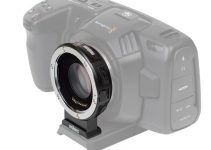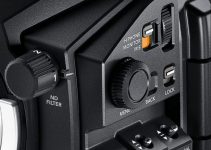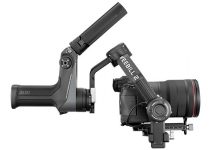A few months ago, Blackmagic Design unveiled the successor to the URSA Mini Pro, the conveniently named URSA Mini Pro G2. The newcomer shares most of the same specs available on the previous version with a couple of notable improvements. The body is exactly the same, the only way to tell them apart is by the small sticker in front and the USB-C port on the side.
With the arrival of this new camera and the hiccups in the distribution of the Pocket 4K, some may have thought of jumping on the G2 wagon. But price difference aside, how do these two cameras perform if compared one to another? JSFILMZ has a take on that in the video below.
Dynamic Range
Namely, the two cameras have 15 (URSA Mini G2) and 13 stops (BPMCC 4K) of dynamic range respectively as these values seem to make sense. The G2 outperforms slightly the Pocket. The difference is minimal and the naked eye mostly can’t tell, but if you look at your waveform metrics, the answer is right there.
Battery Life
This can be a tricky point. The G2 is limited to the V-mount (or Gold Mount) option, meaning it has a lot of recording time up to its sleeve, but at the same time the body itself is cumbersome and those batteries weight a lot.
The Pocket 4K, on the other hand, supports Canon EL-6 batteries natively, much more portable and easy to store. Other than that, there are plenty of adapters and dummy batteries systems that can take advantage of the V-Mount batteries as well. So, for the possibility to choose, the Pocket 4K wins here.
Color Science
Given that both cameras are made by the same manufacturer, you would expect them to perform in the same way. That is mostly true in the open, but if you start to peek at skin tones, you can tell the difference.
The G2 has a little of magenta tint, while the Pocket goes a little bit in the other direction and adds a little of a greenish hue to the captured footage – nothing impossible to fix in post, especially if you use the free copy of DaVinci Resolve Studio that comes with both offerings.
Rolling Shutter
All in all, both cameras perform quite well in that regard. Obviously, it’s not the kind of performance you can get from a camera that has a global shutter, but sensors have improved greatly in the past few years as the rolling shutter is quite reasonable on both. The G2 performs a little bit better if we should pick one.
Low Light
It is well known that Blackmagic cameras do not do well in the dark. The see-through-the-dark kind of performances you get from Sony mirrorless cameras are out of the question here. But a lot has changed from the first production version that could only hit the ISO 800 mark.
Now ISO 3200 is a usable value, both on the G2 and the Pocket, although the Pocket is slightly advantaged by the M4/3 mount that allows adding a SpeedBooster adapter to get a little bit more light on the sensor alongside the dual ISO sensitivity that helps as well.
Screen
Although the screen of the G2 is a little bit smaller, it is also a little bit clearer than the massive screen on the back of the Pocket. The swivel arm, of course, is a welcomed feature.
Size and Ergonomics
There is actually no competition here, the Pocket is the clear winner. The footprints and weights are not even comparable. The Pocket 4K is (relatively) lightweight and compact, whereas the URSA Mini Pro G2 is not only significantly bulkier and heavier but it also ships without a handle, making it so awkward to hold right out of the box.
Recording Format and Menu
The menu structure on the cameras is almost identical as are the format recording options available. The G2 has a little bit more resolution, topping its BRAW recording at 4.6K while the Pocket supports a maximum of DCI 4K resolution.
It’s worth mentioning that albeit not as important in the comparison, the option of downgrading the Pocket 4K to get CinemaDNG recording is a handy feature, although it should be considered as a do-it-at-your-own-risk possibility.
As always, a huge shoutout to whoever is the mind that designed the menus on Blackmagic’s cameras. It’s the easiest to use yet complete design in the industry, no other camera at the moment can even think of topping it.
Recording Media
This is essentially a tie since both cameras have the same recording options, sporting SD cards, ultra fast and ultra expensive CFast 2.0 as well as external SSDs (tethered via the available USB-C port) that seem to be the cheapest and most effective storage solution thus far.
Slo-Mo Capabilities
This is a no-brainer. The main selling point for the G2 is its ability to shoot at higher frame rates than the previous URSA Mini Pro. The 120fps 4.6K and the 300fps FullHD are above and beyond the capabilities of the Pocket 4K.
Audio
The URSA Mini G2 sports two full XLR inputs and that on its own already puts it on top of the Pocket 4K and its single mini-XLR. Furthermore, the pre-amps on the G2 are far superior to those available on its predecessor, making the camera the clear winner in this department.
Price
The elephant in the room. At $1,200 the Pocket is unbelievable. Nothing can beat it, not even close. The URSA Mini Pro is in a completely different ballpark. At $6,000, it’s a full cinema camera, still great bang for the buck, but not even close to the price/performance ratio of the Pocket 4K.
So in conclusion, although it has been a nice comparison to do, these two offerings are in two different fields altogether. The needs of the person buying them will be completely different, but this moreover demonstrates that if you’re a beginning filmmaker who wants to build up some experience, there are not so many options out there better than the Pocket 4K.
[source: JSFILMZ]
Order Links:
Blackmagic Design URSA Mini Pro 4.6K G2 (B&H, Amazon)
Blackmagic Design Pocket Cinema Camera 4K (B&H, Amazon)
Disclaimer: As an Amazon Associate partner and participant in B&H and Adorama Affiliate programmes, we earn a small comission from each purchase made through the affiliate links listed above at no additional cost to you.




